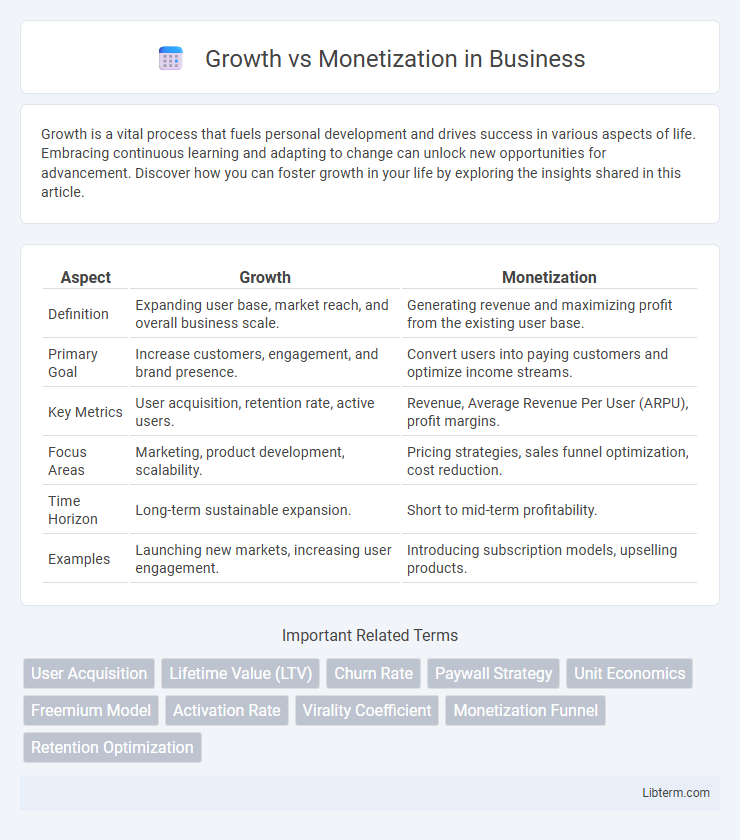Growth is a vital process that fuels personal development and drives success in various aspects of life. Embracing continuous learning and adapting to change can unlock new opportunities for advancement. Discover how you can foster growth in your life by exploring the insights shared in this article.
Table of Comparison
| Aspect | Growth | Monetization |
|---|---|---|
| Definition | Expanding user base, market reach, and overall business scale. | Generating revenue and maximizing profit from the existing user base. |
| Primary Goal | Increase customers, engagement, and brand presence. | Convert users into paying customers and optimize income streams. |
| Key Metrics | User acquisition, retention rate, active users. | Revenue, Average Revenue Per User (ARPU), profit margins. |
| Focus Areas | Marketing, product development, scalability. | Pricing strategies, sales funnel optimization, cost reduction. |
| Time Horizon | Long-term sustainable expansion. | Short to mid-term profitability. |
| Examples | Launching new markets, increasing user engagement. | Introducing subscription models, upselling products. |
Understanding Growth and Monetization
Understanding growth involves tracking user acquisition, engagement metrics, and retention rates to measure how effectively a business expands its customer base. Monetization focuses on converting this growth into revenue through strategies such as subscription models, in-app purchases, and targeted advertising. Balancing growth with monetization requires analyzing customer lifetime value (CLV) and optimizing pricing models to ensure sustainable profitability.
Key Differences Between Growth and Monetization
Growth emphasizes expanding user base and increasing market reach by optimizing acquisition strategies, improving product engagement, and enhancing customer retention. Monetization focuses on converting increased user activity into revenue through strategies like pricing models, subscription plans, advertising, and in-app purchases. The key difference lies in growth targeting scalability and user metrics, while monetization centers on revenue generation and profitability optimization.
Prioritizing Growth: Benefits and Risks
Prioritizing growth allows businesses to expand market share rapidly, attract new customers, and increase brand recognition, which can lead to long-term revenue potential. However, focusing solely on growth may strain resources, delay profitability, and increase operational risks if monetization strategies are not developed concurrently. Balancing rapid expansion with sustainable monetization models is essential to ensure financial stability and scalable success.
Focusing on Monetization: Advantages and Challenges
Focusing on monetization enables businesses to generate immediate revenue streams by leveraging existing customer bases and optimizing pricing strategies, subscription models, and ad placements. This approach ensures sustainable cash flow, allowing reinvestment in product enhancements and marketing efforts. Challenges include balancing user experience with revenue goals, avoiding customer churn due to aggressive monetization tactics, and maintaining competitive pricing in dynamic markets.
Strategies for Driving Sustainable Growth
Effective strategies for driving sustainable growth balance customer acquisition with long-term value creation by integrating data-driven marketing and personalized user experiences. Leveraging product innovation alongside scalable infrastructure ensures consistent engagement and retention while optimizing monetization channels such as subscription models and targeted advertising. Prioritizing customer feedback and iterative development fosters adaptability, sustaining growth momentum without compromising profitability.
Effective Monetization Models and Techniques
Effective monetization models prioritize sustainable revenue streams by leveraging subscription services, freemium tiers, and targeted advertising to balance user growth with profitability. Techniques such as dynamic pricing, personalized offers, and value-based upselling maximize customer lifetime value while minimizing churn. Utilizing data analytics and A/B testing refines these models, ensuring optimized conversion rates and enhanced monetization efficiency.
Balancing Growth and Revenue Goals
Balancing growth and monetization requires aligning customer acquisition strategies with sustainable revenue models to maximize long-term value. Prioritizing scalable user engagement while integrating targeted monetization tactics ensures steady cash flow without compromising expansive growth potential. Effective measurement of key performance indicators (KPIs) like customer lifetime value (CLV) and churn rate enables data-driven optimization of both growth and revenue objectives.
Metrics to Measure Growth vs Monetization
Metrics to measure growth include user acquisition rate, active user count, and customer retention rate, which indicate expansion and engagement levels. Monetization metrics focus on average revenue per user (ARPU), customer lifetime value (CLTV), and conversion rates that reflect financial performance. Tracking these distinct metrics enables businesses to balance scaling efforts with revenue optimization effectively.
Case Studies: Growth-First vs Monetization-First Approaches
Case studies comparing growth-first and monetization-first approaches reveal distinct impacts on user acquisition and revenue generation timelines. Companies adopting a growth-first strategy, such as Airbnb, invested heavily in expanding user base before implementing monetization, achieving rapid market penetration but delaying profitability. Conversely, monetization-first models like Spotify balanced user growth with immediate revenue streams, optimizing cash flow but potentially limiting early user scaling.
Best Practices for Integrating Growth and Monetization
Balancing growth and monetization requires a strategic alignment of product development with revenue models that prioritize user experience and long-term value. Best practices include leveraging data analytics to identify user behavior patterns, enabling personalized monetization strategies that enhance engagement rather than hinder it. Implementing iterative testing of pricing models and growth incentives ensures scalable revenue streams while maintaining competitive acquisition and retention rates.
Growth Infographic

 libterm.com
libterm.com